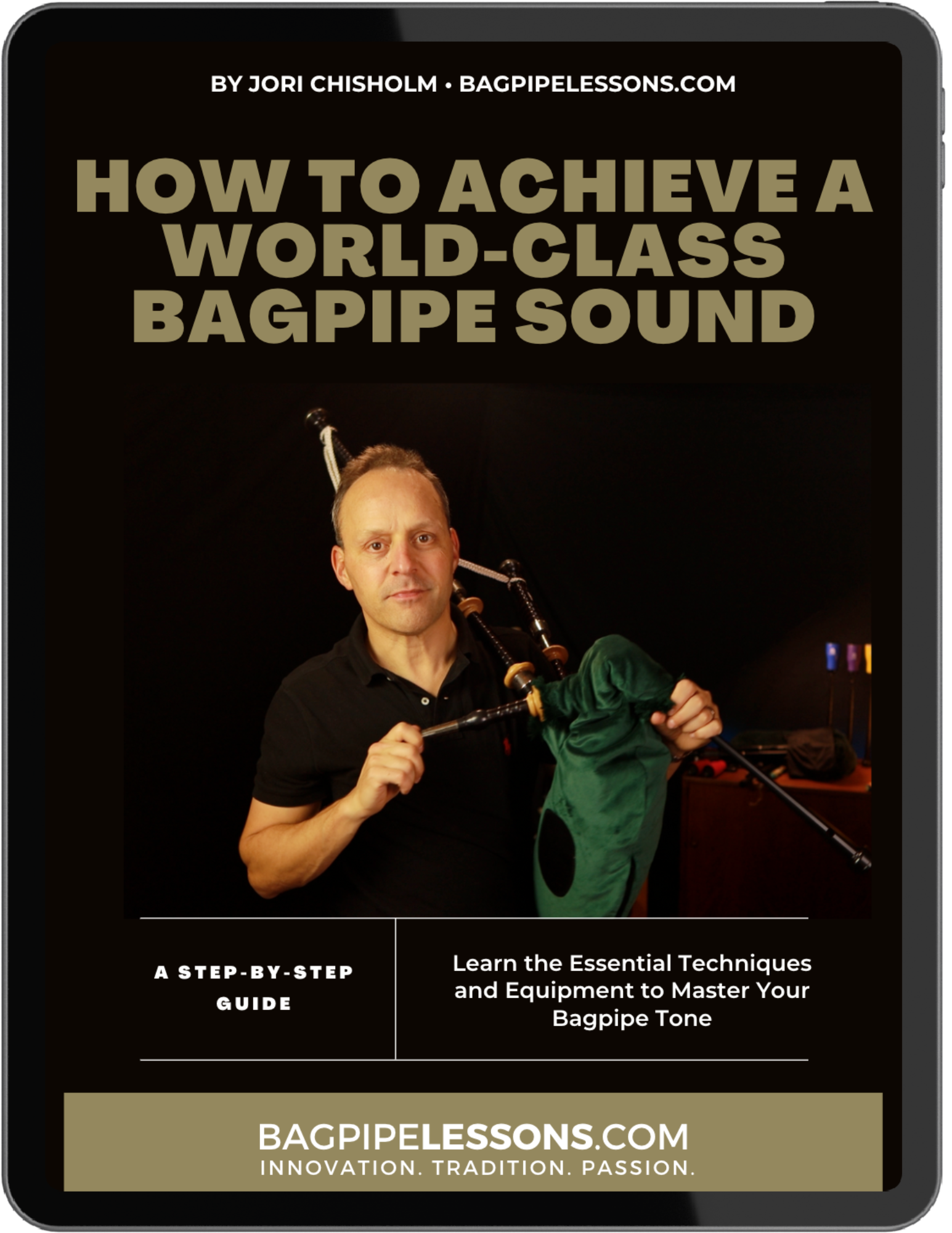
AS FEATURED IN

How to Avoid These Most Common Blowing Mistakes: Tips for a Steadier, More Confident Bagpipe Sound
by Jori Chisholm, Founder of BagpipeLessons.com
Last Updated: July 21, 2024
This video covers the critical skill of steady blowing in bagpipes, addressing common questions about breathing and blowing techniques. It explains the importance of maintaining consistent bag pressure and offers practical tips and exercises for achieving a steady and tunable bagpipe sound.
Mastering steady blowing is essential for achieving a rich and consistent bagpipe sound. This involves maintaining constant bag pressure through a combination of blowing and arm pressure. Key to this is using shoulder and back muscles rather than biceps to apply consistent pressure. Tools like the Bagpipe Gauge can provide instant feedback, helping pipers develop steady blowing techniques quickly. Regular exercises, such as note holding and slow scales, can significantly improve steadiness. Understanding and avoiding common mistakes like fluctuating pressure and incorrect breathing patterns are crucial for a smoother performance.
Watch the video and scroll down to read the full video transcript.
Key Points
🎵 Steady Blowing: Maintaining consistent bag pressure with blowing and arm.
💨 Breathing Rhythm: Develop a regular cadence of blowing and quick breaths.
💪 Muscle Use: Use shoulder and back muscles, not biceps, for arm pressure.
🔊 Bagpipe Gauge: Tool to measure and improve pressure control.
📉 Pressure Consistency: Keep constant pressure regardless of the tune or note.
🎼 High A Tuning: Use High A note to find the ideal pressure.
🚫 Common Mistakes: Avoid fluctuating pressure and different pressures while tuning.
🏋️ Exercises: Note holding and super slow scales to improve steadiness.
🎥 Practical Demonstration: Show proper arm and blowing technique.
Video Transcript: Some of the most common questions I get from people who are new to bagpipes is how the blowing works. Questions like: How does the sound keep going when you take a breath? How do you know when to take a breath? Do you blow harder or softer to play certain notes? Do you coordinate blowing with the squeezing of the bag with your arm?
These are all great questions and I’m going to answer all of them and more in today’s video which is all about what pipers call Steady Blowing. It’s one of the most important skills that every piper needs to know and it’s fundamental to being able to achieve a steady tone that’s easy to tune, and stays in tune. Steady bag pressure is the foundation upon which the bagpipe sound is built. And I’m going to explain it in detail so you understand exactly what’s going on with your blowing, breathing, and arm so you can achieve a perfectly steady bag pressure. I’ll explain the common mistakes that pipers make with their blowing that leads to unsteadiness and I’ll show you some things to practice and an important tool you can use to instantly improve your steadiness.
1. How does the bagpipe work and why is steady blowing so important?
The bagpipes consist of five pipes and a bag. The blowpipe is a simple tube that is used to blow air into the bag, and there are three sound producing pipes: the chanter that provides the main melody, and three drones consisting of two tenor drones and the bass drone that produce the deep, rich, and constant background tone that gives the bagpipes its characteristic sound.
Other woodwind instruments like the saxophone, clarinet, oboe, and bassoon have a single reed that you blow directly with your mouth. When you blow, it makes a sound, and when you stop blowing to take a breath, the sound stops.
The bagpipes allow you to have multiple pipes, each with their own reed. The reeds are enclosed in the instrument so you have multiple pipes with reeds and you don’t need to keep them all in your mouth. Also, the bag allows you to keep the sound going when you take a breath. When you blow into the bag, the bag inflates and your arm moves away from your body. When you take a breath, the bag starts to deflate but you can keep the sound going in the bag by applying pressure with your arm.
So, the bag inflates when you blow into the bag, and it deflates when you take a breath, but you keep the pressure constant by squeezing the bag with your arm. This is the important skill that every piper needs to master and it can be challenging.
2. What exactly is steady blowing and why is it so important to achieve a great bagpipe sound?
What we call steady blowing might more accurately be referred to as steady bag pressure. You achieve this with a combination of blowing into the bag and squeezing the bag with your arm. Because you have to alternate between blowing into the bag and taking a breath, the key to steady bag pressure is the arm. You have to maintain a constant pressure with your arm. When a piper blows into the bag and the bag inflates and the arm moves away from the body, make sure to maintain the pressure with the arm. It can look like the piper is releasing their arm when they inflate the bag, and then pressing down when they stop blowing to take a breath. This doesn’t work. You have to maintain a constant arm pressure. This makes your arm more tired AND it makes it harder to blow into the bag since you are actually blowing against the pressure in the bag that you keep up with your arm. Think of your arm as a weight on the bag, pressing down with the same weight. When you blow into the bag it inflates and pushes your arm away from your body. When you take a breath the bag deflates and your arm moves in, but at all times it’s applying the same amount of pressure. The same weight.
3. Do you try to change the bag pressure depending on the tune or note you are playing?
No. The idea is constant steady pressure. Musicians who play wind or brass instruments will change their blowing pressure to change the pitch or volume or quality of the sound. But bagpipers don’t do this. A big reason for this is the fact that pipers have multiple pipes going at the same time. If you could figure out a way to change the pressure to change the sound of your chanter, it would affect the tone and steadiness of your drones, which you don’t want to do. So the best approach is to learn and master the skill of keeping a steady bag pressure by blowing and squeezing.
4. How do I know when to blow into the bag and when to take a breath?
You want to keep the bag as full as possible without overfilling it to ensure steadiness. A fuller bag makes it easier to maintain steady pressure while you are playing. When you blow into the bag, you inflate it, and at the same time, air escapes through the reeds, producing the sound. When you take a breath, your arm must squeeze the bag to keep the pressure steady and maintain the sound.
Now this is really important: 1. You need to find a rhythm for blowing that keeps enough air in the bag for you to make it possible to maintain a steady pressure and 2. Allow you to inhale to get enough air for yourself.
You should develop a regular cadence where you alternate between blowing into the bag and taking quick breaths. This involves longer, steady exhales into the bag with short, quicker inhales. If you ask other pipers what proportion of the time they are blowing vs inhaling you will get a wide range of answers, 50/50, 70/30, 90/10, etc. Many pipers have no idea. If you look at top players who get a great sound and you can hear how incredibly steady they are with their blowing you will see remarkable consistency. I have watched hours and hours of videos of top world champion pipers and they all maintain a similar blowing/inhale pattern which is about 80-90% blowing and 10-20% inhaling. Amateurs will usually take longer deeper inhales. These longer blowing intervals lead to greater overall steadiness because your bag stays fuller and tighter because it deflates less AND you are using both your arm and your blowing power for most of time and not relying on your arm alone.
Try this the next time you play your pipes and you’ll notice that your overall steadiness will improve. You will also probably notice that your lips and blowing muscles will get more tired. But with practice and time you’ll get stronger and better.
5. What muscles should I be using to squeeze the bag?
You want to use your shoulder and upper back muscles to control the movement of your upper arm away from and toward your body to apply pressure on the bag. Don’t use your bicep to squeeze your bag as this puts a lot of pressure on your forearm and wrist and can lead to tightness in your top hand. The goal is to have a strong constant muscle engagement from your shoulder and back muscles to control your upper arm but your lower arm, wrist, hand, and fingers are relaxed and loose.
A great exercise to work on this is to get your pipes going, play high A, hold it nice and steady, and then take your hand off the chanter while maintaining high A. Then straighten your arm. This helps you focus on using the shoulder and back muscles for bag pressure while keeping the fingers relaxed. Then slowly bring your arm back down to the chanter and try to maintain the pressure with the shoulder and back with relaxed wrist and fingers. The first time you try it you might find it’s really tiring on those muscles. But with practice you will get stronger and you should find your top hand execution will improve with the lighter touch on the chanter.
6. How do I determine the correct blowing pressure? What indicates too much, too little, or just the right amount of pressure?
The exact pressure that your pipes need is determined primarily by the strength of your pipe chanter reed. That’s why the pipe chanter reed is crucial not only for your sound but for the overall comfort and efficiency of your pipes. Check out the other videos on my channel all about selecting and adjusting pipe chanter reeds. If your bag pressure is too low, the chanter reed will stop making sound. We call that a choke — since the reed cuts out and takes a second to kick back in. It’s very disruptive to the performance when that happens, and if you are a solo competition piper, it means you are probably out of the prize list. If your bag pressure is too high, various bad things can happen: the reed can get really sharp, and you can produce really bad sounds like chirps or squeals. Again, it’s very disruptive to your performance and something you definitely want to avoid. So in between is a range of pressures between the choke point and squealing. Is there a way we can pinpoint more precisely the pressure you want to blow your pipes? Yes. The High A. The exact pressure you want to keep your pipes is the exact pressure where the High A sounds the best. Other notes are less picky and can sound okay at a wide range of pressures. The High A has an incredible sound, but it has the narrowest window where it produces that sound. If your High A is under pressure it can sound scratchy or crowy. If it’s over pressure, it can get thin and shrill. But at the right pressure it can have a beautiful resonant vibrant sound that sings. This is the note the top pipers LOVE maybe more than any other note. We want all of our notes to be perfectly in tune but the High A has this special quality or texture of sound that you can only get when your bag pressure is exactly right. So, use your High A to figure out your pressure and keep it there.
7. What are the most common mistakes pipers make with their blowing?
Blowing Harder on Higher Notes Compared to Lower Ones:
Have you ever been told to “blow out your top hand” or “blow out your high A?” It’s possible that you are under blowing your pipes leading to a crowy or flat High A, but it’s a mistake to blow harder on one note than everything else. If you need to blow a little stronger to get your High A to sound great, make sure to maintain that pressure for every note. Don’t overblow the top hand and don’t underblow the bottom. The key is the same, consistent pressure. Many pipers unconsciously increase their blowing pressure when playing higher notes. This results in a sharp, sometimes shrill sound that can disrupt the harmonic balance of the music. The higher notes should blend smoothly with the lower ones, maintaining a consistent volume and tone.
Different Pressure When Blowing and Not Blowing:
It’s common for pipers to have their bag pressure drop when they take a breath. This is caused by insufficient pressure from your arm. Make sure you are keeping a strong and steady pressure with your upper arm on the bag so when you take a breath the pressure doesn’t drop. Keep those inhales quick and that will reduce the amount your bag deflates, which means your bag stays more full, which makes it easier for your arm to maintain the pressure.
Unsteady Pressure When Switching between Blowing and Not Blowing:
One area pipers struggle with is the transition between blowing and taking a breath. Once again, the key is a consistently strong pressure on the bag with your upper arm. Don’t try to coordinate the arm with the blowing. Just keep your arm strong the entire time you are blowing. Don’t release it when you blow and don’t press down harder when you take a breath.
Different Pressure When Tuning Versus Playing:
Let’s face it, there are a lot of things going on when you are playing the pipes. And it’s impossible to give your full attention to everything at the same time. But it’s really important that you maintain the same bag pressure when you are playing AND tuning. It’s quite common for pipers to have a different pressure when tuning compared to playing. That’s a great reason to play High A when tuning your drones — you can hear the quality of the High A when you are at the correct pressure. And when tuning your chanter notes, be careful that you don’t adjust your pressure to try and tune the notes by ear by blowing softer or harder. Keep your strong steady pressure and tune the notes as needed.
Pressure Changes During Hard or Fast Tunes:
Once again, it’s totally normal when you are focused on one aspect of your playing that other areas might suffer. But your goal is to make sure you can maintain a nice steady sound throughout all of your tunes, whether you are tuning up, warming up with simple tunes, or playing your hardest and fastest tunes. This is why taking time to develop ultimate steadiness is important for every piper at every level.
Wrong Pressure During the Start and End of Sets:
How you start and end your performances can dramatically affect the overall effect. Under pressure or fatigue, it’s common for pipers to overblow their chanter which will make the E sharp and out of tune with the rest of the band. Also, it’s a common error to have a pressure drop in the last bar while heading for the cutoff. This will make the chanter flat and possibly even cut out before the end of tune. The solution is to practice your pipe band starts and cut offs to learn to maintain perfect bag pressure with consistency and confidence.
8. What’s the best way to learn to play with steady bag pressure? Are there tools or exercises?
Yes. The best and fastest way to develop steady bag pressure is by using the Bagpipe Gauge. It’s a tool I designed that gives you instant, clear, and precise visual feedback on your pressure control. The Bagpipe Gauge is one of my most popular products. Here’s how you can use it to improve your blowing:
It gives your Clear Visual Feedback: The gauge measures the air pressure inside the pipes when you are playing. It shows even the smallest pressure fluctuations in real time. This allows you to make immediate adjustments, which is crucial for learning how to maintain steady pressure.
It’s Easy to Use: The Bagpipe Gauge is intuitive and straightforward. Attach it to your bagpipe, and it begins providing feedback immediately, making it suitable for pipers at any skill level.
You Improve Immediately: Whether you’re a beginner or an experienced piper, the immediate feedback from the gauge helps you quickly understand and correct your pressure control, leading to noticeable improvements in your sound quality.
9. What are some exercises you recommend to develop my steady blowing skills?
Here are some exercises that can help you refine your ability to maintain steady bag pressure. For the best and fastest results, I recommend you use the Bagpipe Gauge since you get instantaneous visual feedback on your progress, but you can do them without the gauge too but you’ll have to rely on feel and sound.
Note Holding Exercise:
- Choose a single note Like Low A and hold it.
- Focus on maintaining the same pressure throughout.
- Pay close attention to the transitions at the start and end of each breath—your goal is to keep the pressure absolutely steady.
- Then try switching to a different note.
- Engage all your senses during this exercise: listen to the sound of the pipes, watch the Bagpipe Gauge, and feel the pressure applied by your arm, and your lips, and breathing muscles.
- Your goal is to achieve a consistent, unwavering pressure.
This is also the perfect exercise to do if trying to build the skill and stamina to blow your pipes. Maybe you are just getting on the pipes or you are coming back after an extended break. Use a stopwatch to track your progress. Try to make it to 30 seconds, then a minute, then 2 minutes, 5 minutes, and 10 minutes. Start where you are and do it every day as many times as you can and you’ll be amazed at your progress. But the key is consistent practice. “A journey of a thousand miles begins with a single step.”
The Super Slow Scale:
- Begin on Low G and ascend the scale VERY slowly, taking three or four breaths for each note.
- Just like in the previous exercise, your focus should be on maintaining consistent pressure.
The Super Slow High A Scale:
- Start on Low G and play up the scale very slowly, this time with a High A between each note.
- Take three or four breaths per note.
- This exercise is particularly useful for controlling the common tendency to increase the pressure on High A.
- Also, the sound of the High A will let you know that you are at the perfect pressure for your pipes.
A Simple, Slow Tune:
- Select the simplest, slowest tune you know.
- Play it at a very relaxed tempo, focusing intently on the Bagpipe Gauge and the feeling of your arm maintaining steady pressure on the bag.
- The simplicity of the tune allows you to concentrate fully on maintaining solid, consistent pressure throughout the piece.
10. What exactly does the Bagpipe Gauge measure and what else can it do to help me?
The Bagpipe Gauge measures the air pressure inside your pipes when you play. You can watch it while you play for instantaneous visual feedback showing you how steady you are so you can improve your steadiness. You can watch the gauge and observe your own playing to determine exactly where you need to improve so you can get stronger and steadier and make progress FAST.
The Bagpipe Gauge also displays the EXACT pressure of your pipes. A common issue every piper faces from time is when your pipes don’t feel right. I have a whole video on the channel called Why Are My Pipes So Hard? And one of the challenges is to figure out is it me? Or is it my pipes? With the Bagpipe Gauge you get a precise measurement of the strength of your pipes and number, it’s right on the gauge.
Most pipers are right around 30, which is right at the top of the gauge dial here in the middle of the green zone. If your pipes get below 25 your pipes will be easy but you can lose a certain amount of projection and steadiness when the reed gets too easy. Over 35, is just a waste of energy and it can be hard to be steady and play well when you are blowing and squeezing too hard.
The Bagpipe Gauge gives you a clear measurement so you can figure out: are my pipes too hard? Are they taking too much air? Or do I need to build up my strength and stamina?
Check it out on my BagpipeLessons.com Shop at https://bagpipelessons.com/bagpipegauge
We’ve covered a lot today about steady blowing and maintaining consistent bag pressure, key aspects that every piper needs to master for a great sound. Steady blowing isn’t just about blowing into the pipes; it’s about controlling the pressure consistently with your arm while managing your breaths. This fundamental skill ensures your bagpipes are easy to tune and that they stay in tune, providing that rich, melodious sound we all strive for.
To truly enhance your skills and take control of your playing, I highly recommend the Bagpipe Gauge. This tool will transform your practice by providing real-time feedback on your pressure control, allowing you to make instant adjustments and improve rapidly, regardless of your current level. It’s easy to use and highly effective, making it an essential part of your bagpiping toolkit.
Don’t just take my word for it; try it out and see the difference for yourself. Head over to BagpipeLessons.com/bagpipegauge and check out the Bagpipe Gauge. It’s the tool you need to achieve that steady, beautiful sound every piper aims for. Start mastering your steady blowing today and see how much more enjoyable and rewarding playing the bagpipes can be.
For more tips, tricks, and tutorials, subscribe to our channel and hit the bell icon to get notified about our latest videos. Check out BagpipeLessons.com/learn for more resources, including videos, lessons, and guides. Download my free PDF guide called “How to Achieve a World-Class Bagpipe Sound” – the link is in the description below.
If you have any questions, feel free to drop them in the comments section below.
There’s another video on my YouTube channel all about steady blowing and the bagpipe gauge. It’s over one hour long and it was recorded during a live group class I did with members of my BagpipeLessons.com Inner Circle. Membership in my gives you full access to the very best at BagpipeLessons.com including weekly live interactive online classes for pipers of all skill levels and access to my exclusive lesson library filled with hundreds of videos, lessons, tunes, exercises, demonstrations, and more, covering EVERY topic in piping, from music theory to technique, to tuning maintenance, setup, and so much more. And you get personalized support from me to help you reach your piping goals. To find out more about joining my Inner Circle, please visit https://bagpipelessons.com/membership
And subscribe to the BagpipeLessons.com Youtube channel and hit the bell icon to get notified when we post new videos
Thanks and Happy Piping!





